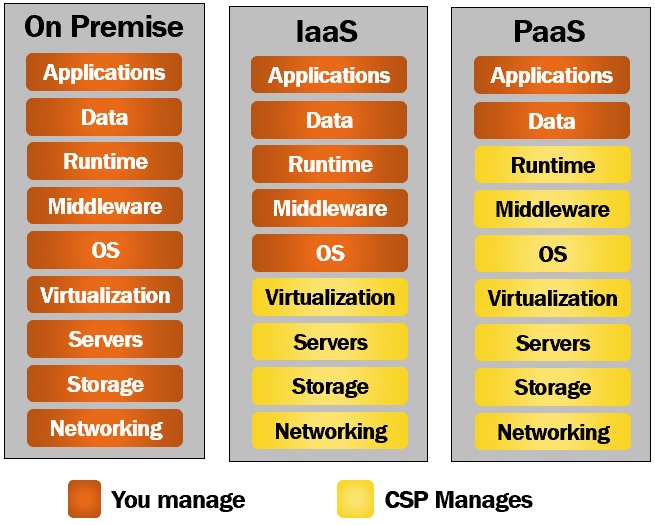What is PaaS in cloud computing | Platform as a Service
In our previous article we understood what is Infrastructure as a Service. In this article we will understand, what is Platform as a Service (also called PaaS), who uses this service and the benefits it provide.
What is Platform as a Service (PaaS)
If you have read our previous article, what is Infrastructure as a Service then, understanding what is Platform as a Service is very easy. It boils down to what we (i.e our organisation) manages verus what the cloud service provider manages. With the, Infrastructure as a Service the cloud service provider manages the infrastructure (i.e Networking, Servers, Storage and Virtualization). We manage everything else (i.e the Operating System, Middleware, Runtime, Data and Application).

When compared with Infrastructure as a Service, Platform as a Service provides an even higher level of abstraction. You can think of it as a layer on top of Infrastructure as a Service. It shifts more responsibility to the cloud service provider. As you can see from the diagram, you manage just your business applications or services and the underlying data. The rest is managed by the cloud service provider. You don't have to worry about any of the things like, managing the network or underlying infrastructure. Installing the operating system updates, critical patches, runtime or middleware components. All these are taken care by the cloud service provider. This gives you, even more time to concentrate on what matters to your business.
Who uses Platform as a Service (IaaS)
Well, it is primarily used by software development teams. As the name implies, it provides the platform for developing software applications. It is a complete development and deployment environment in the cloud. It enables you to deliver everything from simple cloud-based apps to sophisticated, enterprise class cloud-enabled apps.
For example, let's say you want to develop data driven web applications. For this, we need a framework like ASP.NET Core or Java. To store data we need a database like SQL Server or Oracle for example. We need a web server to host and run a web application. Purchasing all these softwares, installing, setting up the development environment and maintaining it, is not only expensive but also time consuming.
With Platform as a Service, the cloud service provider, provides all these softwares, installs and configures them. You have the development platform available with a few clicks in just a few minutes. You pay for the service on a pay-as-you-go basis and access it over a secure Internet connection. When you no longer need the service, you shut things down and stop paying.
Windows Azure, AWS Elastic Beanstalk, and Google App Engine are few examples of Platform as a Service.
Advantages of Platform as a Service
Platform as a service is a layer on top of Infrastructure as a Service. So it has all the benefits of IaaS plus the benefits specific to PaaS. IaaS provides many benefits like
- Reduced financial risk
- Deployment Speed
- Provision resources from geographically closer locations
- Auto scaling resources (i.e the underlying virtual infrastructure) up and down depending on demand
We discussed IaaS benefits in detail, in our previous article. The following are the benefits specific to platform as a service.
Greatly reduces development time
Platform as a Service greatly reduces development time. Just imagine the amount of time it takes to procure your own infrastructure, purchase all the softwares, install, configure and set up your own development environment. With Platform as a Service, in just a few minutes with a few simple clicks you gain instant access to a complete software development environment. It also provides templates and reusable application components and features such as search, directory services, security features and so on.
Great support for global teams
Platform as a Service, supports global teams. To access the development environment, all you need is an internet connection. So your development team members can be located anywhere in the world, I mean, in any remote location. It doesn't really matter. As long as they have an internet connection, they can connect and work together on projects.
Develop for multiple platforms
PaaS provides options for developing multiple platforms, such as computers, mobile devices and browsers. In short, it makes developing cross-platform apps quicker and easier.
Affordability
Affordability is another great benefit. Cloud supports pay-as-you-go model. So with it organisations of all sizes including small organisation and even individuals are able to use sophisticated development software, business intelligence and analytics tools that they could not afford to purchase outright. So with the pay-as-you-go model you simply pay a monthly fee for as long as you want to use them.
© 2020 Pragimtech. All Rights Reserved.

